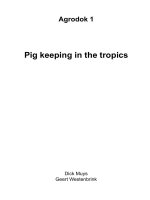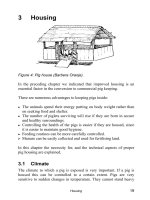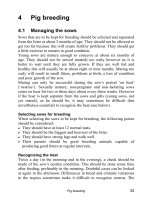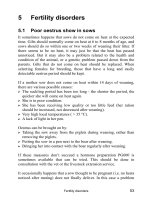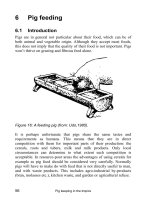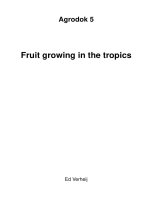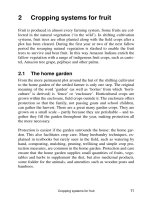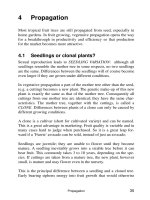Fruit growing in the tropics - Part 10 pot
Bạn đang xem bản rút gọn của tài liệu. Xem và tải ngay bản đầy đủ của tài liệu tại đây (110.74 KB, 22 trang )
Layout and establishment of the orchard
69
10 Layout and establishment of the
orchard
This is usually one of the first subjects in books on fruit growing, but
in fact all the other subjects should be clear in your mind before you
start planning the layout of an orchard. You should take into account:
? Differences in vigour between cultivars
? Measures to control tree vigour (drought, root pruning, girdling,
etc.)
? Requirements with regard to cross-pollination.
10.1 Tree spacing
Orchards are traditionally planted ‘on the square’, e.g. 10 x 10 m for
mango. This is all right for large seedling trees with their immense
canopies. If smaller tree size allows doubling the number of trees per
ha to 200 (approx. 7 x 7 m), other planting patterns may not be advan-
tageous. But if 400 trees or more can be planted per ha, the trees
should remain so small that you can allow them to form a closed row
or hedge. This means that, at 400 trees per ha, instead of a spacing of
5 x 5 m on the square, a spacing of 6 x 4 m, i.e. ROW CROPPING,
becomes attractive. Sufficient light should penetrate the hedge to pro-
duce good quality fruit even on the lowest limbs.
The square planting pattern is based on the notion that all trees grow
equally well and that you can fairly accurately predict the size of the
mature trees. Both notions are false. There is usually much variation in
tree size, even in a single cultivar. Also, it is quite common for trees to
remain much smaller or to grow much larger than anticipated. A suc-
cession of a few good crops as soon as the tree comes into bearing
greatly helps to limit tree size.
As shown in figure 19 the open fringe around each tree planted on the
square has become an open alley in the row-cropping model. The
closer spacing in the row means that a more vigorous tree can make
Fruit growing in the tropics
70
up for a weaker neighbour. If growth is disappointing, the trees should
still fill the rows and intercropping in the alleyways can be continued
for a few more years. If tree vigour is excessive, the alleyways serve
as an outlet for some time. And if vigour cannot be controlled, grub-
bing half the trees will result in a new row alignment with a spacing of
8 x 6.25 m.
Figure 19: Planting on the square compared with row cropping,
both at 400 trees per ha and similar variation in tree size
In comparison with square planting row cropping is a very flexible
tree arrangement. Row cropping also lends itself to planting along the
contours of a slope, or across the direction of the prevailing wind on a
windswept site. Row cropping is very much on the increase now that
growers are trying to limit tree size through clonal propagation and
other methods.
When using clonal planting material or named cultivars, it is advisable
to plant several cultivars side by side in the orchard in order to:
? Spread the risk of a cultivar not living up to your expectations
? Facilitate cross-pollination.
Layout and establishment of the orchard
71
Lack of vital information makes it risky to concentrate on a single cul-
tivar. For most crops, the available information about cultivars is
largely limited to the FRUIT: shape, colour, taste, shelf life, etc. How-
ever, for the grower information about the TREE, such as vigour, pro-
ductivity, disease tolerance, is just as important. Textbooks have little
if anything to say about these tree characteristics, in part because they
are strongly influenced by local growing conditions (and in budded or
grafted trees they are determined by the rootstock as well as the culti-
var). Hence, unless there is sufficient local information, the right spac-
ing is a gamble, yield predictions are guesswork and diseases and
pests may play havoc with the trees.
So you have to look around you, consult extension staff, other growers
and nurserymen. If you are not sure, just plant rows 1, 3, 5, 7, etc. with
the main cultivar and, for instance, another cultivar in rows 2, 6, 10,
etc. and a third cultivar in rows 4, 8, 12, and so on. Planting three cul-
tivars in this way will create good conditions for cross-pollination.
Moreover, weak growth in one row may be compensated by more vig-
orous growth in the next row (and if you know this beforehand you
can adjust spacing within the row to the vigour of the cultivar). Crop
care is facilitated because within a row the requirements with regard
to pruning, crop protection, harvesting, etc. are the same.
10.2 Orchard establishment
Tree growth during the early years largely determines when the trees
come into bearing. As explained in Chapter 2, in most instances
growth of bearing trees needs to be curtailed to balance it with fruit-
ing. If this is the case you can only safely boost tree vigour during the
pre-bearing years. A robust tree frame with well-spaced limbs formed
during several, prolonged flushes in the first 2 years, is an asset for
life. It is why looking after the tree during the first few years is em-
phasised here.
Textbooks generally recommend digging large planting holes (e.g. 40
x 40 x 40 cm) well in advance of the planting season, keeping topsoil
Fruit growing in the tropics
72
and subsoil separate, so that when the tree is planted the topsoil can be
spread over the roots first. This is fine if you have time, but as a rule
labour can be better spent on mulching and/or watering the young
trees.
If the trees are to be tied to a
stake, it is advisable to set out the
stakes first. Plant the tree on the
lee side of the stake and not on
the windward side, so that the tree
will not rub against the stake. Dig
a hole big enough to accommo-
date the roots; for bare-rooted
trees the roots may be spread in a
V-shaped hole extending on both
sides of the stake, as in figure 20.
Make sure that the union of
grafted or budded trees is well
above ground level, also after the
soil has settled, to prevent the
scion from striking root.
Growers often lose interest in their trees during the long years waiting
for the first crop. This is understandable, but it is also a big mistake.
Having invested in good planting material and careful planting, you
should go on investing in your trees. Pamper them with a generous
mulch and if necessary protect them against browsing cattle and
strong wind, provide temporary shade and apply water. If the soil can
be kept moist, the young trees will also respond well to manure or fer-
tiliser.
Young trees need attention almost daily. Climbing weeds need little
time to reach the top of the newly planted tree. Root suckers and side
shoots that emerge too low on the trunk waste the tree’s energy and
need to be removed. If done early, the side shoots can simply be
brushed off (advantages: little labour required, little growth wasted).
Figure 20: V-shaped planting
hole and stake
Layout and establishment of the orchard
73
Crickets, caterpillars, night-feeding beetles, etc. can quickly finish the
leaves on a small tree. Look closely; often shading material (set up to
protect the young tree against the sun) hides the first indications of
trouble. Frequent inspections can nip infestations in the bud: crickets
and caterpillars can be caught by hand. This may sound primitive, but
a larger cricket or caterpillar is hard to poison with insecticide, be-
cause it eats far less in relation to its body size than a tiny one. Hence,
treatments with insecticides also require frequent rounds for timely
control.
Set your standards high. Do not be satisfied if all trees survive so that
there is no need to fill gaps. Your aim should be uniform, vigorously
growing trees that hold the promise of rich rewards.
Fruit growing in the tropics
74
Appendix: Horticultural traits
Explanatory notes
Fruit crops are listed alphabetically per family, to show which crops
are closely related, having common characters. The table gives traits
of the flowers (including compatibility in pollination) and the fruit.
Common propagation methods and horticultural status are also given.
The number in the first column corresponds to the bold number in the
Index.
Key
Flower traits
perf Flowers perfect (hermaphrodite)
mix Flowers of different sex (e.g. male or female; male or perfect) in the same inflores-
cence
mono Male and female flowers in separate inflorescences on the same tree (monoecy)
di Flowers of different sex (e.g. male-flowering or female-flowering) on separate trees:
dioecy.
Pollination
x Flowers self-incompatible (cross-pollination essential).
y Self-pollination unlikely (e.g. stigmas not receptive when pollen is shed).
s Flowers self-compatible.
Fruit traits
clim Fruit climacteric, ripens after being harvested mature
n-c Fruit non-climacteric, no further ripening after harvest
par Fruits commonly seedless: parthenocarpy.
Horticultural status
uni Seedlings uniform, showing little variation; trees usually propagated from seed
sel Clonal propagation recommended, but selection has not yet resulted in named
cultivars.
Var Selected mother trees used for propagation (through seed or clones); cultivars be-
ing named.
Cvs Clonal propagation of named cultivars commonly practiced.
Brackets
(…) Trait applies only to some varieties or cultivars
Appendix: Horticultural traits
75
Table 4: Fruit crops listed alphabetically per botanic family
Nr. Common name Flower traits Polli-nation Fruit traits Hortic. status
Anacardiaceae
1 cashew mix n-c var
2 mango mix s clim cvs
3 ambarella perf sel
4 red mombin perf y (par) sel
5 yellow mombin mix sel
6 marula di sel
Annonaceae
7 cherimoya perf y clim cvs
8 atemoya perf y clim cvs
9 sugarapple perf y clim cvs
10 soursop perf y clim uni
Bombacaceae
11 baobab perf sel
12 durian perf (s/x) clim cvs
Bromeliaceae
13 pineapple perf x n-c par cvs
Caricaceae
14 papaya di x clim cvs
Ebenaceae
15 persimmon (black) mix (di) (par) var
16 persimmon (oriental) (mix) di clim (par) cvs
Flacourtiaceae
17 kei apple di
18 governor plum perf var
Guttiferae
19 mangosteen di uni
Lauraceae
20 avocado perf y clim cvs
Leguminosae
21 tamarind perf s cvs
Meliaceae
22 santol perf y cvs
23 langsat perf par cvs
Moraceae
24 breadfruit mono y clim par var
25 breadnut mono y var
26 jackfruit mono y clim var
27 Amazon tree grape di
Fruit growing in the tropics
76
Nr. Common name Flower traits Polli-nation Fruit traits Hortic. status
Musaceae
28 banana, plantain mix par cvs
Myrtaceae
29 guava per (s/x) clim (par) cvs
30 grumichama perf s? n-c sel
31 pitanga, Surinam cherry perf n-c sel
32 Java apple, wax jambu perf s? n-c var
33 Malay apple, pomerac perf n-c var
34 jambolan perf n-c (par) var
Oxalidaceae
35 carambola perf (s/x) n-c cvs
Palmae
36 pejibaye, peach palm mix y var
37 salak di (mix) var
Passifloraceae
38 giant granadilla perf y clim uni
39 purple passionfruit perf s clim var
40 yellow passionfruit perf y clim cvs
Proteaceae
41 macadamia perf y cvs
Punicaceae
42 pomegranate perf cvs
Rhamnaceae
43 Indian jujube perf x (par) cvs
Rosaceae
44 apple perf (s) clim (par) cvs
45 pear, nashi perf x clim (par) cvs
46 peach, nectarine perf s clim cvs
47 plum perf x (y) clim cvs
48 loquat perf (x) y cvs
49 strawberry perf (y) s n-c cvs
Rutaceae
50 casimiroa, white sapote perf, (x) y cvs
51 kumquat perf cvs
52 grapefruit perf n-c (par) cvs
53 lime mix (x) n-c (par) var
54 mandarin perf (x/s) n-c (par) cvs
55 orange perf n-c (par) cvs
56 pummelo perf (x) n-c cvs
Sapindaceae
57 longan mix cvs
Appendix: Horticultural traits
77
Nr. Common name Flower traits Polli-nation Fruit traits Hortic. status
58 lychee mix n-c cvs
59 rambutan di (mix) n-c cvs
Sapotaceae
60 caimito perf s var
61 canistel, egg-fruit perf var
62 mamey sapote, sapote perf clim var
63 sapodilla, chicosapote perf (y) clim cvs
Vitaceae
64 grape perf n-c (par) cvs
Fruit growing in the tropics
78
Further reading
Barbeau, G., 1990: Frutas tropicales en Nicaragua. Editorial Cien-
cias Sociales, Managua, Nicaragua, 397 pp.
Carlos, Jr., J.T. (Editor), 1990: South Pacific Fruit Production. CTA,
Wageningen, The Netherlands, 142 pp.
Dupriez, H. & P. de Leener, 1998: Trees and multistorey agriculture
in Africa. Land and Life, Belgium & CTA, The Netherlands, 280 pp.
ISBN: 2-87105-101-X and 92-9081-178-1.
Epstein, S., 1998: Propagating plants, an organic approach. Fam-
bidzanai Permaculture Centre and Mambo Press, Zimbabwe & CTA,
Wageningen, The Netherlands, 140 pp. ISBN: 0 86922 726 2
Morton, J.F., 1987: Fruits of warm climates. Creative Resource Sys-
tems Inc., Winterville, N.C. USA, 503 pp. ISBN 0 9610184 1 0
Nakasone, H. Y. & R.E. Paull, 1998: Tropical fruits. CAB Interna-
tional, Wallingford, UK, 445 pp. ISBN 0 85199 2544
Samson, J.A.,2nd edition 1986: Tropical fruits. Longman Group UK
Ltd, Harlow, England, 335 pp. ISBN 0 582 40409 6
Suranant Subhadrabandhu & Yaacob Othman, 1995: Production of
economic fruits in South-East Asia. Oxford Un. Press, UK. ISBN 9
67653 0468
Verheij, E.W.M. & R. Coronel (Editors), 1991: Plant resources of
South-East Asia, Vol. 2: Edible fruits and nuts. PUDOC, Wagenin-
gen, The Netherlands, 446 pp. ISBN 90 220 0986 6. (also published in
Thai, Vietnamese, Tagalog and Bahasa Indonesia)
Further reading
79
Verheij, E.W.M. & H. Lövenstein, 2004: A nurseryman and his
trees. AgroSpecial 1, AGROMISA, Wageningen, The Netherlands, 43
p. ISBN 90-77073-82-5
Fruit growing in the tropics
80
Useful addresses
Horticultural Research Centre, Malaysian Agricultural Research
and Development Institute (MARDI)
POBox 1230, GPO Kuala Lumpur, MALAYSIA
(+60) 3-89437263
www.mardi.my
Horticultural Research Centre, Ministry of Agriculture
POBox 810, Marondera, ZIMBABWE
(+263) 79-24122
www.hridir.org/hri/search
Department of Horticultural Science, University of Natal
Private Bag X01, Scottsville
3209 Pietermaritzburg, SOUTH AFRICA
(+27) 33-2605969
www.sciag.unp.ac.za
Horticultural Research Institute Tengeru (HORTI-Tengeru)
POBox 1253, Arusha, TANZANIA
Tel: Duluti 94
The Green Belt Movement
POBOx 67545, Nairobi, KENYA
(+254) 20-573057/571523
www.greenbeltmovement.org
TOFNET, Trees on Farm Network for East and Central Africa
Coordinator: World Agroforestry Centre (ICRAF),
POBox 30677-00100, Nairobi, Kenya
www.tofnet.org
Useful addresses
81
WAFNET, West African Fruit Network
Coordination: Plant Genetic Resources Centre
POBox 7, Bunso, E/R, GHANA
Contact for commercial fruit crops:
Institut Senegalois des Recherches Agonomiques (ISRA)
c/o Mr. Demba Sidibe,
BP 34, Ziguimchor, SENEGAL
tel: 991-12-05, fax: 991-12-93
e-mail:
Contact for underutilized fruit crops:
National Centre for Genetic Resources and Biotechnology
(NACGRAB)
c/o Prof. C.P.E. Omaliko, Director
POBox 331, Abuja, NIGERIA
tel: (234)9-5235765, fax: (244)9-5233903
e-mail:
Institute of Agricultural Research for Development (IRAD)
c/o Dr Joseph Kengue, Chargé de Recherches
BP 2067, Yaoundé, CAMEROUN
tel: (237) 238549, fax: (237)237571
e-mail:
Global Horticulture Initiative
Interim Administrative Office
c/o AVRDC - The World Vegetable Center
P.O. Box 42, Shanhua, Tainan
Taiwan 74199, R.O.C.
www.globalhort.org/index.html
Fruit growing in the tropics
82
Glossary
air layering a form of layering in which a ball of soil in a
polythene cover is wrapped around a girdle in
the branch to be layered; after roots grow into
the soil ball the layer can be separated
annual plant a plant that completes its life cycle within one
year
apomixis reproduction by seed formed without sexual
fusion, hence a form of cloning
axil the upper angle between a leaf and the stem
biennial bearing a more or less regular alternation of heavy
and light fruit crops in successive years
biological control crop protection using natural ways to control
a pest or disease, e.g. by natural enemies, or
barriers such as a net to exclude birds
botanical name unique name, given by a botanist, under
which the plant species is known
cambium a layer of meristematic tissue between wood
and bark with cells which divide to form
more wood and bark
cauliflory flowers borne on the trunk and/or large
branches
cincturing see girdling
climacteric fruit a fruit which, if mature, ripens after harvest-
ing
climacterium a spurt in the ripening process of climacteric
fruit
clone a group of plants originating by vegetative
propagation from a single plant and therefore
having the same genotype
compatible of cultivars as pollinators: capable of sexual
union, and thus of forming seeded fruit;
in budding/grafting: capable of forming a
lasting stock-scion union
Glossary
83
cross-pollination placement of pollen on the stigma of a flower
that is not of the same clone
cultivar (cv) a cultivated variety, as distinct from a variety
that exists in the natural vegetation
deciduous a perennial plant that is leafless during a
(brief) part of the year
dichogamy flower in which pollen is released before or
after the stigma is ready to be pollinated, thus
preventing self-pollination
dioecious bearing flowers of a single sex, male or fe-
male, and borne on different plants (dioecy)
dormancy a state of rest of seeds or buds, prohibiting
sprouting even under favourable growing
conditions
embryo the rudimentary plant within a seed
evergreen bearing leaves all year long, because leaf
change is gradual
floral bud bud that is in the process of laying down
flower initials
flower bud unopened flower
flush a brief period of rapid shoot growth, preceded
and followed by a period of quiescence, even
under favourable growing conditions
gene the bearer of a single genetic trait, located on
a chromosome
genotype the genetic make-up of an organism compris-
ing all its genes
girdling removal of a narrow ring of bark from the
tree trunk or the tree limbs to starve the roots;
also called cincturing
harvest index the harvestable produce as a fraction of the
total biomass produced by the crop in a given
year
hermaphrodite bisexual; with stamens and pistil in the same
flower
Fruit growing in the tropics
84
hormones growth substances, produced in various or-
gans and moving through the plant in small
quantities to direct the growth processes in
dividing cells
inbreeding breeding by sexual fusion of pollen and egg
cells of the same or closely related genotypes
incompatible in pollination: not able to achieve sexual un-
ion; in budding or grafting: not resulting in
lasting union between stock and scion
indeterminate of shoot growth: not limited to expansion of
leaf initials which where already present in
the bud
inflorescence the floral structure consisting of more than
one flower
juvenile phase the period between germination and the first
sign of flowering
marcotting see air layering
monoecious with flowers of a single sex, male or female,
but borne on the same plant (monoecy)
node the point on the shoot where a leaf is borne
non-climacteric fruit a fruit which must ripen on the tree because it
does not ripen after being harvested
orthotropic shoots upright shoots that mainly serve to increase
tree size in trees that also have more horizon-
tally growing (plagiotropic) shoots
ovary the enlarged base of the pistil which contains
the ovules and grows into the fruit
ovules the immature seeds in the ovary before fertili-
zation
parthenocarpy the production of fruit without true fertiliza-
tion and hence without true seed (fruit usually
seedless)
perennial plant a plant living for many years
perfect flower a flower possessing both male (stamens) and
female (pistil) organs
Glossary
85
pesticide a chemical used to control pests; selective
pesticides kill only the target pest, broad
spectrum pesticides kill a wide range of in-
sects
pistil the female part of a flower consisting, when
complete, of ovary(s), style(s) and stigma(s)
pistillate flower a flower with pistil(s) but lacking stamens
plagiotropic shoots shoots growing more or less horizontal and
bearing all or most fruit, contrasting with up-
right (orthotropic) shoots in the same tree
pollen tiny grains discharged by the anthers, contain-
ing the male element
pollination the transfer of pollen to the receptive stigma,
if dry largely by wind, if sticky mainly by in-
sects
polyembryony the growth of two or more embryos in an
ovule, resulting in more than one seedling
emerging from the seed; only one of these
may be a true seedling, the others are clonal
quiescence rest of plant parts, when there is no outwardly
visible signs of growth; in this Agrodok
mainly used for buds between flushes
rootstock the part of a budded/grafted plant below the
union, bearing the roots; above the union is
the scion
scion the part of a budded/grafted plant above the
union; below the union is the (root)stock
self-fertile capable of fertilisation and setting seed after
self-pollination
self-pollination pollination with pollen from the same plant or
plants of the same clone
self-sterile not capable of sexual union and seed produc-
tion after self-pollination
sexual reproduction propagation by seed following pollination of
the flower and fertilization of the egg cell
Fruit growing in the tropics
86
shoot a young stem bearing immature leaves, at
least near the tip
stamens the male organs of the flower, each consisting
of a filament and an anther
staminate flower a flower bearing only stamens, no pistil
stigma the tip of the pistil that receives the pollen
style the part of the pistil connecting the ovary
with the stigma
sucker shoot emerging from an adventitious bud,
usually on a root or the tree trunk
taproot the root that first emerges from the seed and
normally becomes the main root of a plant
raised from seed
variety a distinct type within a species which occurs
naturally; in cultivation a variety is called a
cultivar
water shoot vigorous sucker with juvenile traits emerging
on or close to the trunk, often following in-
jury (e.g. from pruning)
whip a long unbranched shoot
Index
87
Index
The index lists crops alphabetically by their common names used in
this Agrodok. For each crop the botanic name is given, and if the crop
is still well known by a former botanical name, that name is included
in brackets. Names in italics refer to crops not usually included in the
commodity group fruit and nuts. A bold number is the crop’s number
in the Appendix.
Common name(s) Botanical name (Former
name)
Page; nr in Appendix
Africado; see Butter
fruit tree
Amazon tree grape Pourouma cecropiaefolia 11,58; 27
Ambarella,
Great hog plum
Spondias cytherea (S. dulcis) 28;3
Apple Malus domestica 13,24,25,30,37,40,41,46,48,
53,54,55,59,61;44
Areca palm Areca catechu
Atemoya Annona cherimola x
A. squamosa
34; 8
Avocado Persea americana 18,24,31,35,37,40,,57,62; 20
Banana, Plantain Musa 6,9,12,13,14,15,19,21,22,34,
37,56,64; 28
Baobab Adansonia digitata 57; 11
Brazil cherry,
Grumichama
Eugenia dombeyi
(Eugenia brasiliensis)
30
Breadfruit, Breadnut Artocarpus altilis (A. commu-
nis)
23,34,37,55; 24
Butter fruit tree Dacryodes edulis 32,58
Caimito, Starapple Chrysophyllum cainito 60
Canistel, Egg-fruit Pouteria campechiana
(Lucuma nervosa)
11,24; 61
Carambola Averrhoa carambola 49,52; 35
Cashew Anacardium occidentale 24,36,37; 1
Casimiroa,
White sapote
Casimiroa edulis 24,31; 50
Cherimoya Annona cherimola 7
Chiku, Sapodilla Manilkara zapota
(Achras zapota)
24,28,34; 63
Citrus Citrus 18,23,24,31,37,38,40,41,45,
46,52,61,62,64
Clove Syzygium aromaticum 30
Fruit growing in the tropics
88
Common name(s) Botanical name (Former
name)
Page; nr in Appendix
Cocoa Theobroma cacao 23,27,34
Coconut Cocos nucifera 15,16,19,20,21,22,34,56
Coffee Coffea arabica 8,23,26,27,3,0,34,45,46,60
Custard apples Annona species 24,25,27,58; 7,8,9
Date palm Phoenix dactilifera 15,21
Duku, Langsat Lansium domesticum 23
Durian Durio zybethinus 12,23,26,27,34,37,46,57,65,
66; 12
Egg-fruit: see Canistel
Giant Granadilla Passiflora quadrangularis 38
Governor plum Flacourtia inermis 18
Grape Vitis vinifera 11,23,30,34,37,42,43,53,54,
58,64; 64
Grapefruit Citrus x paradisi 52
Great hog plum: see
Ambarella
Grumichama:
see Brazil cherry
Guava Psidium guajava 12,19,24,54,55,56,59,61,65;
29
Hog plum: see Mombin
Indian jujube Ziziphus mauritiana 24; 43
Jackfruit Artocarpus heterophyllus 23,27,34,37,55,59,65; 26
Jambolan Syzygium cumini
(Eugenia jambolana)
34
Java apple,
Wax jambu
Syzygium samarangense
(Eugenia javanica)
32
Kaki:
see Persimmon
Kapok Ceiba pentandra 34
Kei apple Dovyalis caffra 61; 17
Kechapi, Santol Sandoricum koetjape (S. indi-
cum)
24; 22
Kumquat Fortunella margarita 51
Langsat: see Duku
Lime Citrus aurantifolia 37; 53
Lychee Litchi chinensis 31,32,48,49; 58
Longan Dimocarpus longan
(Euphoria longana)
24,31,37,60; 57
Loquat Eriobotrya japonica 24,31; 48
Macadamia Macadamia integrifolia 32; 41
Malay apple,
Pomerac
Syzygium malaccense
(Eugenia malaccensis)
24; 33
Index
89
Common name(s) Botanical name (Former
name)
Page; nr in Appendix
Mamey sapote Pouteria sapota
(Calocarpum sapota)
24; 62
Mandarin,
Tangerine
Citrus reticulata (C. nobilis) 12,19,33,56,59,64; 54
Mango Mangifera indica 8,12,13,16,17,18,19,23,24,
28,31,32,34,37,38,48,49,50,
51,52,53,54,55,56,59,6,0,61,
65,66,69; 2
Mangosteen Garcinia mangostana 24,28,34,37,38; 19
Marula Sclerocarya birrea 6
Mombin (red),
Spanish plum
Spondias purpurea (S. dul-
cis)
28; 4
Mombin (yellow),
Hog plum
Spondias mombin (S. lutea) 28; 5
Nashi, Pear (oriental) Pyrus pyrifolia (P. serotina) 24,25,30,34,46,53; 45
Nutmeg Myristica fragrans 23,28,34
Oil palm Elaeis guineensis 21
Papaya Carica papaya 6,12,15,16,19,20,21,22,23,
34,36,37,55,56,58,65; 14
Passionfruit Passiflora 23,34,36,37,42,58,62
Passionfruit (purple) Passiflora edulis f. flavicarpa 39
Passionfruit (yellow) Passiflora edulis f. edulis 40
Peach Prunus persica 30,45,53; 46
Peach palm, Pejibaye Bactris gasipaes
(Guilielma speciosa)
36
Pear (oriental): see
Nashi
Pejibaye: see
Peach palm
Persimmon (black) Diospyros digyna 24; 15
Persimmon (oriental),
Kaki
Diospyros kaki 24,57; 16
Pineapple Ananas comosus 6,12,13,14,15,19,21,22,34,
37,56,57; 13
Pitanga,
Surinam cherry
Eugenia uniflora 31
Plantain: see Banana
Plum Prunus salicina (P. triflora) 24,25,30,37,44,46,53; 47
Pomegranate Punica granatum 24,25,31; 42
Pummelo Citrus maxima 56
Rambutan Nephelium lappaceum 12,23,24,28,29,34,49,52,55,
57,59; 59
Rubber Hevea brasiliensis 28,37
Salak Salacca zalacca (S. edulis) 58; 37
Fruit growing in the tropics
90
Common name(s) Botanical name (Former
name)
Page; nr in Appendix
Santol: see Kechapi
Sapodilla: see Chiku Manilkara zapota
(Achras sapota)
Sisal Agave sisalana 21
Soursop Annona muricata 28,34,36,37,55; 10
Spanish plum: see
Mombin
Starapple: see Caimito
Strawberry Fragaria x ananassa 37; 49
Sugarapple, Sweetsop Annona squamosa 45,55; 9
Surinam cherry: see
Pitanga
Sweet orange Citrus sinensis 33,34; 55
Tamarind Tamarindus indica 24; 21
Tangerine: see
Mandarin
Tea Camellia sinensis 41,43
Wax jambu: see
Java apple
White sapote: see
Casimiroa

